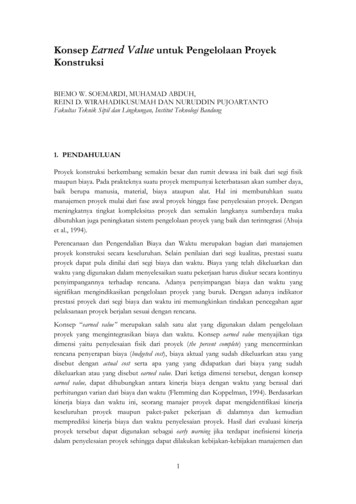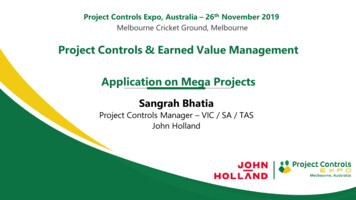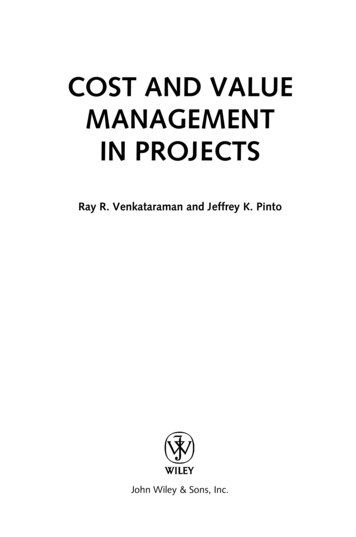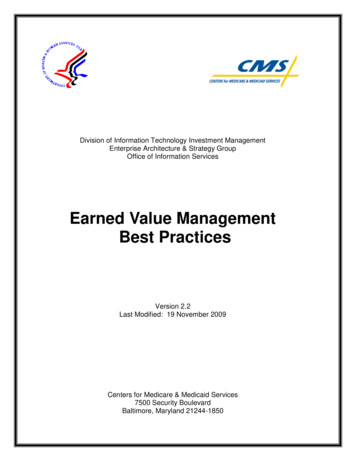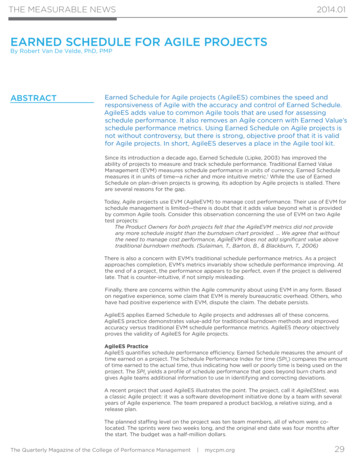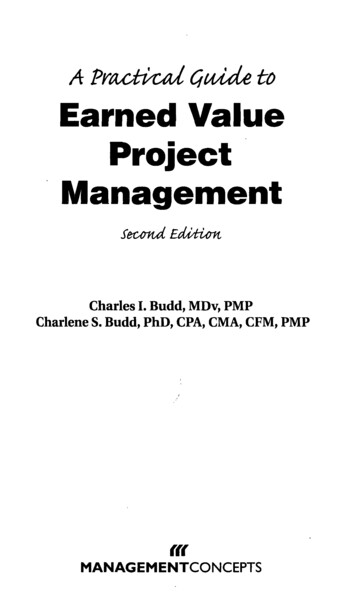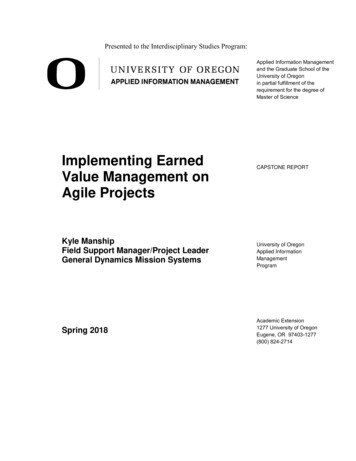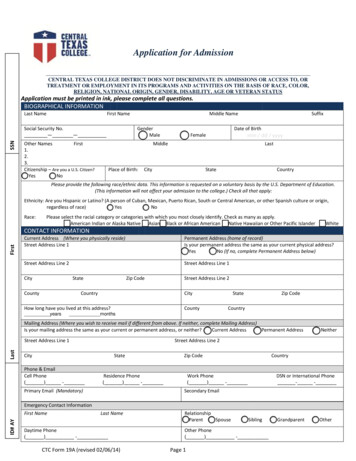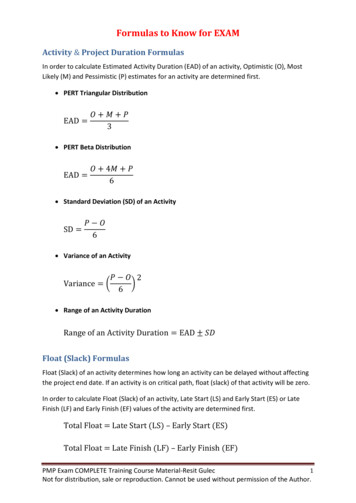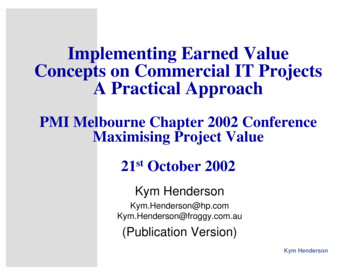
Transcription
Implementing Earned ValueConcepts on Commercial IT ProjectsA Practical ApproachPMI Melbourne Chapter 2002 ConferenceMaximising Project Value21st October 2002Kym com.au(Publication Version)Kym Henderson
Introduction1. What is Earned Value ?2. Why Use Earned Value ?3. The Key Benefit of Earned Value4. Prerequisites for an Earned Value Management System5. Achieving Integrated Project Reporting6. How to Calculate and Plot Earned Value7. The Cost Variance and Cost Performance Index8. The Schedule Variance and Schedule Performance Index9. Suggested Earned Value Approach for Commercial IT Projects10. Suggested P&L Format11. Predictive Uses of Earned Value: Earned Value IEAC Formulae12. Example Project #113. Potential Issues with Earned Value14. Benefits and Conclusions15. Frequently Asked Questions (FAQs)16. Additional Information and Lessons Learned2Kym Henderson
Source: Earned Value, Clear and Simple. Mr. Tammo T. Wilkens, Los Angeles County Metropolitan TransportationAuthority http://www.acq.osd.mil/pm/paperpres/wilkins art.pdfWhat is Earned Value ?The simplest way to think of Earned Value is toequate it with physical progress Earned Value is also a measure of progress there is a direct relationship between Earned Valueand per cent completeIt is expressed in a common unit of measureUsually either dollars or hoursTo facilitate variance analysis– which requires common units of measure3Kym Henderson
Why Use Earned Value ?Earned Value is the only project planning and controlmethodology which I know of, that integrates projectCost performanceSchedule performance ANDTechnical performanceinto a single methodologyFrom which objective measures of project performanceare readily available includingVariance metrics and indices (cost and schedule)– Which helps confirm project performance to date; and– Provides guidance into areas for corrective actionFormula based predictors of future performance4Kym Henderson
The Key Benefit of Earned ValuePersonal experience and the academic literature highlights thatComparing plan versus actual costs especially for IT projectsis not adequate for accurately establishing, assessing,monitoring and predicting project performanceThis “financial accounting” approach fails to consider thetechnical achievement (physical progress) realised to dateProgress achieved is implicitly equated to the costs expendedThis can be very dangerous for IT projects whichAre usually very “people intensive”Often have deliverables which lack direct physical visibility– e.g. bespoke software development source code5Kym Henderson
Personal Experience .In IT project recovery situations personally managedThere have been remarkably close correlations to plannedversus actual costs (see Example Project #1)The project has been seriously troubled, often for extendedperiods of timeAnd what seemed blindingly obvious in retrospecthad not been detected in advance over that timeIn the common situation of concurrent IT project qualityfailure (process and product)Very large costs can be incurred with little useful (re-useable)outputs in spite of the cost and effort expended6Kym Henderson
To Emphasize the Point A close correlation to planned versus actual costs,particularly on an IT project, may simply meanThat the planned number of peopleHave sat on the planned number of seatsFor the planned period of timeAnd incurred the planned (and expected) amount of costs overthat timePlanned versus actual costs provided NO information aboutwhether the planned amount of technical achievementor physical progress actually took place over thattime7Kym Henderson
Earned Value Management PhilosophyEarned Value was developed by Government, initially the USDepartment of Defense (DoD) for managing very large,complex acquisition programsThe (implied) Earned Value management philosophy isbased on the management and control of costsThe Government Program Manager is measured on his or herconformance to the cost baselineEarned Value is a cost based measureThis has implications (to be discussed) for applying EarnedValue to the commercial IT environment8Kym Henderson
Why Calculate Earned Value ?Once EV can be assessed with “reasonable accuracy”Virtually all Earned Value Variances, Indices and predictiveformulae are calculated from the basicBudgeted Costs or “Planned Values” [BCWS or PV]– Which includes Budgeted Costs at Complete [BAC]Actual Costs [AC or ACWP]Earned Value [EV or BCWP]A spreadsheet which automates the calculations and graphsthe results allows the Project Manager toSanity check, analyse and understand the resultsObjectively determine the adverse impacts affecting the projectProactively plan and implement corrective actions9Kym Henderson
Prerequisites for an Earned Value ManagementSystem (EVMS)Project management fundamentals should be in placeIncluding a Work Breakdown Structure .If being implemented on an organisational basissenior management commitment is essentialIncluding a willingness to accept and act on the outputs andmessages provided by the EVMSAt the personal level, a willingness to try something new andpotentially challengingAn “integrated project reporting system” is essentialPreferably organisationally based10Kym Henderson
Achieving Integrated Project ReportingEven in Un-integrated Corporate EnvironmentsWBS DictionarySchedulePlanned Values(Budgeted Costs)Actual CostsEarned Value(% Complete)Integrated Project Status(Earned Value) ReportsThe concept is to align project activities defined in the WBSinto both the schedule and financial accounting and/or timerecording systemsThis should be within the Project Manager’s control11Kym Henderson
Achieving Integrated Project ReportingEven in Un-integrated Corporate Environments continued WBS DictionarySchedule1) Initial scheduleshould be part ofthe Proposal.2) Detailed scheduledevelopment, updateand monitoringshould be part of theproject planning,control and reviewprocessesPlanned Values(Budgeted Costs)Project Proposal Cost Cost Re-estimates Authorised Changes Unauthorized Changesincluded in product Planned ValuesActual CostsEarned Value(% Complete)Should be obtainedfrom the CorporateAccounting and / orTime RecordingSystem(s)Estimated by ProjectManager and / orTeam as part ofproject review andcontrol processesIntegrated Project Status(Earned Value) Reports12Kym Henderson
Project Planned and Actual Cost Curves:Data should be available from existing corporate sourcesWBS DictionarySchedulePlanned Values(Budgeted Costs)Actual CostsPlanned Values [Costs] (PV or BCWS)Earned Value(% Complete)Actual Costs (ACWP) 10 8 6 4 2 0Week 1 Week 2 Week 3 Week 4 Week 5 Week 6 Week 713Week nKym Henderson
The Issue: How to Calculate and Plot Earned ValueWBS DictionarySchedulePlanned Values(Budgeted Costs)Planned Values [Costs] (PV or BCWS)Actual CostsActual Costs (ACWP)Earned Value (EV or BCWP) 10 8 6 4 2? 0Week 1 Week 2 Week 3 Week 4 Week 5 Week 6 Week 714Week nEarned Value(% Complete)The Issue:How to calculate and plotEarned Value:a) With minimum effortb) Without an EarnedValue software package;c) Without the perceivedoverheads associated withlarge, complex [DoD]acquisition contracts ?Kym Henderson
How to Calculate and Plot Earned Value:1) “Classic” Earned ValueBring all realised Earned Value amounts for each task toaccount for the period using the rules for EV accounting:– “0 – 100”– “50 – 50”– “Interim Milestone”– “Apportioned effort”– “% Complete”– “Level of Effort”Earned Value at the project level is the sum of all subordinateEarned Values achieved or realisedProject to Date: Earned Value cumFor the Period: Earned Valueperiod15Kym Henderson
How to Calculate and Plot Earned Value:1) Classic Earned Value continued Example Using Interim Milestone MethodPlanned Value for Task #1 100– Task #1 is divided into 4 equally weighted intermediatedeliverable milestones– Completing each intermediate milestone results in anEarned Value of 25 being recognisedIssues with “Classic” Earned ValueRequires very significant levels of detailed project planning– This level of planning is usually considered an unjustifiableoverhead, especially in the commercial IT sectorRequires an Earned Value software package to implement– Which imposes its own costs and overheads16Kym Henderson
How to Calculate and Plot Earned Value:2) Weighted Average Method (to derive Percentage Complete)Assign a percentage of project total forthe defined “WBS elements”(WBS Element Planned Costs /Budget at Complete) * 100Assess Percentage Complete for each“WBS element”The project “Weighted Average”Percent Complete is the sum of theWBS element % complete xWBS element % of project totalTransfer the “Weighted Average”Percent Complete into the Earned ValueReporting spreadsheetWBSElements%ofStatus DatesProject Week1 Week2 Week3 Week4 Week5 Week6 Week7Project ManagementSales &DistributionMaterials oLiveSystemOrg. ChangeManagementBasis Support &SecurityPost .0%5.0%10.0%5.0% 10.0% 15.0% 20.0% 25.0% 30.0% 35.0%7.5% 12.0% 20.0% 25.0% 30.0% 40.0% 45.0%12.5% 15.0% 20.0% 22.5% 30.0% 35.0%10.0% 17.5% 22.5% 30.0% 40.0%15.0% 17.5% 25.0% 30.0% 35.0% 47.5% 50.0%5.0% 12.5% 12.5% 12.5% 20.0%25.0% 25.0% 25.0% 25.0% 25.0%5.0% 10.0% 15.0% 20.0% 25.0% 30.0% 35.0%PercentageofProjectTotal 100.0%ProjectPercentComplete 3.3% 6.2% 10.9% 14.3% 17.0% 22.0% 25.5%The greater the granularity of defined “WBS elements”, the moreaccurate the Project % Complete calculation will be17Kym Henderson
How to Calculate and Plot Earned Value:3) Derive from Schedule “Percentage Complete”Transforming the Earned Value formula% Complete Earned Value [EV]cum/ Budget At Complete [BAC]results inBAC x % Complete EVcumAn illustrative exampleBAC 1,000Percent Complete cum assessed as being 50%Earned Value cum 1,000 x 50% 500 500 is the Earned Value cum, expressed in dollars whichrepresents the physical progress achieved to date by this projectOne technique is to use Microsoft Project (or other schedulingtool) calculated Percent Complete18Kym Henderson
Microsoft Project Calculated Percent Completes1) “Percent Complete”Calculated based on task durations2) “Percent Work Complete”Calculated based on task resource loads and durationRequires a resource loaded schedulePercent Work Complete is more accurateBut “Percent Complete” is preferable to nothing– A personal view based on actual experience19Kym Henderson
Earned Value Derived From Percentage CompleteIs viewed as “more subjective” and less preferable by EarnedValue purists and Earned Value theoryAn “accuracy” versus “cost and overhead” trade-off decisionRequires a “realistic” project schedule to be in place withRegular (weekly) progress updates performedSufficient rigour and “sanity checking” to provide confidence inthe accuracy of the Percent Complete resultPersonal experience suggests thatA “proper” schedule update is very difficult to manipulateUsing Earned Value results in greater care being taken with thetask level Percentage Completes claimedThe Key Benefit: Allows Earned Value to be calculatedwithout an Earned Value software package20Kym Henderson
WBS – Schedule AlignmentIf the schedule is NOT aligned to the WBS and financial systemEarned Value reporting at the project level remains possibleHowever, alignment permits Earned Value to be applied at amore granular (ie. Control Account - Work Package) levelThis enables the specific areas causing variances to bedetermined more quickly and easilyAnd tracking specific corrective actions for effectivenessOnce Earned Value is calculated and plotted in an Earned ValueReporting spreadsheetEV Variances and Indices can be automatically calculatedTo enable an objective assessment of the project statusTo facilitate Variance analysis; andIssues identification and corrective action21Kym Henderson
The Cost Variance (CV) andCost Performance Index (CPI)CV Earned Value - Actual Costs-A negative CV indicates that the “physical progress” wasachieved at a greater cost than forecast [unfavourable]-A positive CV indicates that the “physical progress” wasachieved at a lesser cost than forecast [favourable]CPI Earned Value / Actual CostsA CPI less than 1 indicates that the “physical progress” wasachieved at a greater cost than forecast [unfavourable]A CPI greater than 1 indicates that the “physical progress”was achieved at a lesser cost than forecast [favourable]The CV and CPI measures the efficiency which the physicalprogress was achieved compared to the Budgeted Cost BaselineCorrective action should focus on improving the productivity withwhich work is performed22Kym Henderson
The Schedule Variance (SV) andSchedule Performance Index (SPI)SV Earned Value - Budgeted Costs– A negative SV indicates that the “physical progress” wasachieved at a slower rate than planned [unfavourable]– A positive SV indicates that the “physical progress” wasachieved at a faster rate than planned [favourable]SPI Earned Value / Budgeted Costs– A SPI less than 1 indicates that the “physical progress” wasachieved at a slower rate than planned [unfavourable]– A SPI greater than 1 indicates that the “physical progress”was achieved at a faster than planned [favourable]If Earned Value is using dollars as the unit of measureUnderstanding a dollar based SV is often an issue23Kym Henderson
How Does the “Schedule Variance”Relate to the “Real Schedule” ?The SV is derived from cost accounting dataNot the “real schedule”The SV does not identify specific work performedie. Critical path versus non critical path workThis requires detailed analysis of the “real schedule”The SV does not measure timeThis requires detailed analysis of the “real schedule”Even if a project is late the SV will converge and becomezero when the project is completedThe Earned and Planned Values will become equal BUTCheck the CV and BAC for the impact of schedule delay !Corrective action should focus on improving the timelinesswith which work is performed24Kym Henderson
Source: Emerging Ideas, Relating EVM to “Real” Schedules; Wayne Abba, Dekker Pty Ltdhttp://www.acq.osd.mil/pm/paperpres/relating evm and real schedules cpm 2000.pptSchedule Variance: StrengthsProvides reliable earlywarningThere is no costvariance but thereis a large negativeschedule varianceWhen large, early andunfavorableObservations on 100’s of[US] DoD contractsSV - Reflects cost/scheduleintegrationWork breakdown structurePerformance measurementbaseline25Kym Henderson
Source: Emerging Ideas, Relating EVM to “Real” Schedules; Wayne Abba, Dekker Pty Ltdhttp://www.acq.osd.mil/pm/paperpres/relating evm and real schedules cpm 2000.pptSchedule or “Accomplishment” VarianceAbba suggests that a better term for the SV is“Accomplishment Variance”It measures the volume of work accomplished versus thevolume of work plannedA large negative measure of the volume of workaccomplished compared to the volume of work plannedOught to raise the alarm bells over the project statusNOTE: The CPI and SPI permits discussion of project cost /financial and “accomplishment” variances without disclosingactual dollar amounts26Kym Henderson
Suggested EV Approach for IT ProjectsLimit Earned Value to the Services componentOften the highest cost and risk component of an IT projectFor non services components of project(e.g. hardware and software licenses)Account for using standard financial practiceCost Variances on these items are usually outside the ProjectManager’s controlThird party services depends on nature of engagementFixed price: Account for as above for milestone based orperiodic payments (with appropriate oversight mechanisms)T&M work: EV recommended for large and/or critical work– A significant risk item for the prime contractor27Kym Henderson
Suggested Project Profit and Loss FormatSeparate Professional Servicesfrom other P&L line itemsSample Profit and Loss ReportFor xyx Project as at xx/xx/yyPlanThe usual practicePlan Costs (Baseline)Actuals to DateEstimates to CompleteEstimates at Complete– Actuals ETC EACEstimated Variance At CompleteHighlights the degree of formalscope change;Risk realisation; andThe P&L impact ( or -)Estimate toCompleteEstimate AtCompleteEstimatedVariance AtCompleteProfessional ServicesSubdivide P&L to showShow CRs and Risk separatelyActuals toDateRevenueLine ItemsCostsLine ItemsGross MarginGross Margin PercentThird Party ServicesRevenueLine ItemsCostsLine ItemsGross MarginGross Margin PercentHardwareRevenueLine ItemsCostsLine ItemsGross MarginGross Margin PercentSoftware LicensesRevenueLine ItemsCostsLine ItemsGross MarginGross Margin PercentGrand TotalsRevenueCostsGross MarginGross Margin Percent28Kym Henderson
Project P&L Format continued A P&L format like this used in conjunction with Earned Valuegraphs, metrics and reportsProvides a clear and comprehensive project status in bothcommercial and delivery termsIncluding the estimated final outcomes AND information toevaluate the “reasonableness” of projected outcomesFocused Project Management of the cost baselineSignificantly improves the probability of achieving asatisfactory commercial outcome for a projectRecommended goals for Project Managers(1) Achieve the approved cost baseline(2) As adjusted by additional revenue generated fromformal scope changes29Kym Henderson
Predictive Uses of Earned Value:Earned Value IEAC FormulaeIEAC means Independent Estimate At CompleteEAC estimates based on a formula driven approachA generic IEAC formula Actual Coststo dateIEAC ACWP cumWhat the project (theoretically) needs toachieve to completeThe Budgeted Cost of Work Remaining (BAC – EV cum)PFA PerformanceFactor30Kym Henderson
Predictive Uses of EV:Earned Value IEAC Formulae continued Performance Factors for the BCWRCPI (Discussed in the PMBOK) or SPI– US DoD studies suggest that the CPI cum and SPI cum arepredictive of the final EAC80/20 (.8 x CPI) (.2 x SPI)– This suggests the BCWR is 80% influenced by the CPI and20% influenced by the SPICPI * SPI– This estimates the most pessimistic outcome especially insituations of unfavourable cost and schedule performanceAn IEAC provides a simple, credible method for sanity checking theclaimed EAC without a full “bottom up” (re)estimate, claimedEarned Value and % CompleteSource: Using The Earned Value Cost Management Report To Evaluate The Contractor’s Estimate At Completion, David S.Christensen, Ph.D. Acquisition Review Quarterly—Summer 1999 http://www.acq.osd.mil/pm/paperpres/chrcost.pdfKym Henderson31
Predictive Uses of EV:Earned Value IEAC Formulae continued The IEAC must also be used with cautionAll performance factors are based on historic cumulativeproject performance– Which may not necessarily continue into the future– More recent project performance indices can be used if desiredThe IEAC cannot compensate for future inaccuracies oromissions in the Budgeted Costs Baseline– ie. “missing” (unbudgeted) future work or additional unbudgetedwork arising from issues or risk resolution– Until this work commencesHowever, the IEAC providesA useful sanity check of claimed project performance to date andthe claimed EACAn “early warning signal” of sub optimum performance32Kym Henderson
Source: The Earned Value Body of Knowledge (EV-BOK) ( 10/98) presented by Quentin W. FlemingWWW.QuentinF.com tContracts at 15% complete point(Gary Christle) GIVEN:1. Overrun at completion will not beless than overrun to date.2. Percent overrun at completion will begreater than percent overrun to date. CONCLUSION: You can't recover!!700 WHO SAYS: More than 300 major DOD contracts since 1977. WHY:If you underestimated the near, there is no hopethat you did better on the far term planning.33Kym Henderson
Source: The Earned Value Body of Knowledge (EV-BOK) ( 10/98) presented by Quentin W. FlemingWWW.QuentinF.com tCost Risks Can Be Managed(with an “early warning” signal)A key benefit of Earned ValueIdentifying cost risk early in the project life cycleallows for corrective action with most of the costbudget still intact .StatisticalEACRangePM's EAC BAC US DoD experience indicates that attheir projects 15% - 20% completionpoint, they can predict the final EACwithin a statistical range “Early warning” signals I use arethe EV metrics including IEAC, CPI CV & SPI - SV ) trends over time15%CompleteTime34Kym Henderson
Example Project #1 (IEAC S Curve)Forecast Costs (BCWS)Actual Costs (ACWP)Earned Value (BCWP)IEAC2000.01800.01600.01400.01200.01000.03) Very significant increases in theIEAC (and Project Mgr EAC) in spite ofthe small ( 470K) initial cost baseline.Project BAC re-baselined at 1.45M,slightly lower than June IEAC.Revised schedule estimated a 5month delay for delivery.4) Reconstruction of the IEAC (80/20rule) highlighted a significantprobable EAC overrun in Feb 98.This information was not required bythe project reporting or oversightsystem, meaning that this “earlywarning signal” was not available.2) While significant additional costs(and schedule delays) were beingincurred to recover the project800.0600.0400.01) Percent Complete (and EV) wasreduced from 43% to 30% from Mar toMay 98 after project recovery started200.00.0Nov-97 Dec-97 Jan-98 Feb-98Mar-98 Apr-98 May-98 Jun-9835Jul-98Aug-98 Sep-98Oct-98 Nov-98Kym Henderson
Example Project #1 (CPI & SPI)CPISPITarget CPI and SPI1.201.001) In spite of probable manipulation ofpercent complete data, reconstructionof the reported data highlightednegative CPI performance from Nov 97and negative SPI performance from Feb98.2) As CPI & SPI data was not required tobe included in monthly reports, these“early warning” signals were not visible.3) Project performance issues were notaddressed until the Apr 98 timeframe0.800.600.400.200.00Nov-97 Dec-97 Jan-98Feb-98Mar-98Apr-98May-98 Jun-9836Jul-98Aug-98 Sep-98Oct-98Nov-98Kym Henderson
Potential Issues with Earned Value“Manipulation” of Earned Value DataSurely Not !4.15 Despite these high percentages there stillseems much to be done to complete thesubmarines. CMACS data indicate that HMASCollins' CMACS packages were 87 per centexpended when it was launched in August 1993,and that later submarines will be launched aftergreater levels of expenditure. For example, data onsubmarine 05 - Sheean - shows its CMACSpackages are 91 per cent expended. However,physical distribution drawings of December 1997show Sheean's hull still in seven pieces indicatingsome of its systems are yet to be assembled fully,integrated into other sections of the submarineand set to work. (emphasis added)4.14 CMACS data provided below shows, inrespect of the contract sum attributable toeach submarine, the proportion spent to June1997:SubmarinePercentage of fundsexpended01 - Collins9802 - Farncomb9803 - Waller9704 - Dechaineux9605 - Sheean9106 - Rankin87The integrity of an EVMS is absolutely dependent on theintegrity of the Earned Value calculationsAustralian National Audit Office Audit Report No. 34 1997-98 New Submarine Project pp 41, m Henderson
Potential Issues with Earned ValueBehavioural and Organisational IssuesThe “Beach Inquiry” into Cancellation of the US 4 Billion USNavy A12 Stealth Fighter Program in 1991 highlighted “theabiding cultural problem” ofInterpreting information in the most favorable light– “possibilities were always cast in a positive, optimistic, light”– In spite of a growing body of evidence to the contraryPreferring to defer dealing with unfavorable information– “these leaders considered whether to bring news of adversedevelopments forward, but decided not to do so”The report also highlighted that this “problem” was not uniqueto the militarySource: Memorandum For The Secretary Of The Navy 28 Nov 90, Subject: A-12 Administrative Inquiry; Chester Paul BeachJr df38Kym Henderson
Source: The Costs And Benefits Of The Earned Value Management Process; David S. Christensen, Ph.D.Acquisition Quarterly Fall 1998 #costs benefitsTen Benefits of EVMS1. It is a single management control system that provides reliable data2. It integrates work, schedule, and cost using a work breakdown structure3. The associated database of completed projects is useful for comparativeanalysis4. The cumulative cost performance index (CPI) provides an early warningsignal5. The schedule performance index provides an early warning signal6. The CPI is a predictor for the final cost of the project7. It uses an index-based method to forecast the final cost of the project8. The “to-complete” performance index allows evaluation of the forecastedfinal cost9. The periodic (e.g., weekly or monthly) CPI is a benchmark10. The management by exception principle can reduce information overload11. Earned Value has developed a large body of public domain knowledge andGovernment case studies. These studies includes information that would beextremely sensitive and classified “commercial in confidence” in the privatesector39Kym Henderson
ConclusionsThe presentation has sought to explainThe benefits of using Earned Value for commercial IT projectsTechniques which can be used to calculate Earned Value without anEarned Value software package and minimum overheadsSuggest methods for achieving “integrated project reporting” even in“un-integrated” corporate environments– Which can be applied at a personal level; or– As an incremental improvement at the Corporate levelThis presentation describes personal experience and practicesgained over many years in a number of commercial IT companiesI use Earned Value where I am obliged to or not becauseI can objectively status, track and monitor overall project performanceEarned Value’s “early warning signals” allow me to position for or takecorrective action, usually before others even realise there is an issue40Kym Henderson
Final Thoughts“The more you do of what you’re (already)doing, the more you’ll get of what you’ve(already) got”Source: When Projects Go Wrong; Paul C Dinsmore PMP, PM Network, November 2001 at p16The (software development) Solution Centre I workfor is moving to Earned Value as quickly as we canbecause we’ve realised it’s the only way we canwork out where these projects are really at Source: Barry Smith, Senior Project Manager; Member PMI Sydney Chapter41Kym Henderson
FAQ #1 Do you supply the Earned Valuespreadsheet with the presentation ?NOUse of the Earned Value worksheet requires training andfamiliarisation in its useAn Earned Value short course has been run in Sydneysponsored by PMI Sydney ChapterCourse duration is 1 day– 4 x 2 hour evening sessions– Or as a 1 day courseContact details– Kym Henderson: 61 (0)414 428 537– kym.henderson@froggy.com.au42Kym Henderson
FAQ #2 Are there any papers on applying EarnedValue to software development projects ?There are many public domain papers on the applicability of Earned ValueManagement to software development projects either on or referenced by the USDefense Department Acquisition website mlComprehensive Bibliography of Earned Value Literature. Christensen, D (July b.htmlA very extensive bibliography of Earned Value literature (published and un published)Recommended papers to get started are:1.2.3.Earned Value, Clear and Simple. Wilkens, Tammo T (1999)http://www.acq.osd.mil/pm/paperpres/wilkins art.pdfAn 8 page paper which provides a comprehensive but “clear and simple” description of theelements of Earned Value and reasons for using an Earned Value Management SystemEarned Value Project Management--A Powerful Tool For Software Projects. Fleming& Koppelman (1998) http://www.acq.osd.mil/pm/paperpres/fleming1.pdfA very readable 4 ½ page paper which summarizes the history of Earned Value anddescribes “10 musts” to implement Earned Value on all projects. Most of these “musts”should be implemented whether Earned Value is used or not !Practical Software Measurement, Performance-Based Earned Value (2001) Solomon,P omon.pdfA comprehensive 5 page paper which covers the issues and provides recommendations toenable accurate measurement of progress on software development projects.43Kym Henderson
FAQ #2 Are there any papers on applying EarnedValue to software development projects ?Specific links to some other software papers at this site include:Statistical Process Control of Project Performance, (2002) Lipke /lipke.aspSoftware Project Planning, Statistics, and Earned Value (2000) Lipke, W, Jennings pke.aspApplying Management Reserve to Software Project Management Lipke, W. H. pke art.htmlWalt Lipke is the deputy chief of the software division at the Oklahoma City Air LogisticsCenter. He has 30 years of experience in the development, maintenance, and managementof software for avionics automated testing. Lipke has written a number of public domainarticles on advanced techniques applicable to software development and Earned Value.His organization is certified to Level 4 of the SEI’s CMM.16 Critical Software Practices for Performance-Based Management by Jane T.Lochner (1999) hner.aspUsing Earned Value for Performance Measurement on Software Development Projects(1995) Christensen, D ects.pdfInclude
2 Kym Henderson Introduction 1. What is Earned Value ? 2. Why Use Earned Value ? 3. The Key Benefit of Earned Value 4. Prerequisites for an Earned Value Management System
